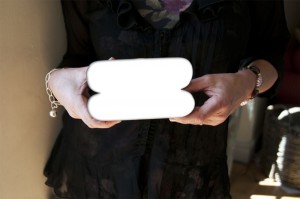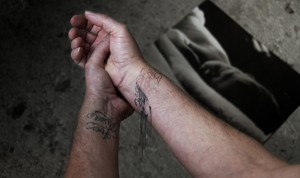Rosa’s show “In Absentia” has been a major success.   In fact the whole Foundation Art show at Oxford Brookes was extraordinary for the variety and depth of talent on display.   But I’m not sure who was most surprised when following the opening speeches for the private view last Friday, Rosa was awarded a special prize for the best exhibition in the photography/animation department, Rosa or her many friends that had turned up for the evening.   In any case, we all made straight for the room on the first floor to see what she had done.    To me, Rosa’s work confirmed the power that the photographic image can have.   Ten images strategically placed in a bare room with subdued lighting, told the story of her loss (of our loss) with such economy, with such potency, they brought an almost visceral silence to the space that reduced many to tears.
On the far wall was a three and half metres long photograph of all of Joshua’s belongings as they had been returned to us from Vietnam.   Isolated in space in a long line were his wallet, his passport, his glasses, toothbrush, his watch (set to Vietnamese time), his phone, remnants of an unfinished  journey set out in forensic detail.

On the opposite wall six photographs of friends and family holding, I should say, cradling some of these ‘belongings’, or what we took to be these items because they had been cut out of the image leaving a crude gaping hole. Â Â Â We know from captions who is holding what, but these are close ups of hands and torso only, producing a kind of semi-anonymity that releases the viewer from a personal engagement with us, Joshua’s family, leaving him/her free to imagine the pain of his absence in a more universal way.
This combination a tender  emptiness and the objective reality, evokes such a sense of absence and such a real sense of Joshua’s not being here, one viewer described it as “a knife through the heart”.
On a third wall are three surreal images accompanied by sets of headphones with audio recordings.  These are representations of dreams that Rosa has collected again from family and friends since Josh died.    From her introduction we read that while Joshua’s belongings are a sad reminder of the empty space now left in our lives, ‘this space is partially filled by our dreams – the only place where his presence is beyond doubt”.     Photography is of course (as is film) an excellent purveyor of the subconscious, though one would not usually associate this with an absence of doubt.     Rosa  has looked beyond that ‘knife through the heart’ reality to a darker world of our imaginings.   On the one hand the photographs depict strange and  unsettling  reality, unmediated by judgement or opinion, cold in their clarity, obscure in their meaning.    But listening to the tape recordings, with voices gently fading in and out and over each other, is more sympathetic as well as a more intimate  experience – one gets the sense that when we  dream of Joshua, we experience him alive and well but with the full knowledge that he has died.   He always appears in our dreams as his very real self, but both alive and dead at the same time, and perhaps this is what Rosa is hinting at when she describes his presence as beyond doubt.    It is however clear that many of these dreams act as a consoling medium – what ever the substance, our encounter with Josh is often the same – “take it easy” he seems to be saying, “I’m Ok, there’s no need to worry”.     Death for Joshua holds no fear and we can take comfort from his words.
Though Josh is very much present in the dreams in the audio recordings, Rosa returns to her theme of absence with the photographs themselves.  She has chosen to illustrate this section with an interpretation of my own dream in which I have woken to discover  my new tattoos peeling off my arms.     In contrast to the more reassuring dreams on the  tape, this dream and these images have anxiety and insecurity written right through them.    Constructed in the style of stills from a bad horror movie, they are again notable for an absence of Joshua.      That horror movie is of course our daily reality – the unreality of  of our dreamworld, paradoxically, sometimes feels like the safest place to be.
In contrast to the more reassuring dreams on the  tape, this dream and these images have anxiety and insecurity written right through them.    Constructed in the style of stills from a bad horror movie, they are again notable for an absence of Joshua.      That horror movie is of course our daily reality – the unreality of  of our dreamworld, paradoxically, sometimes feels like the safest place to be.
So what is Rosa saying here? Â Â It strikes me that she is in the process of forming a new relationship with her brother. Â Â Taken as a whole these photographs are a reflection on all of our journeys through grief. Â Â Â The show might have started out as a piece about absence and loss but in the end we discover that however painful and desperate and frightening our feelings are, they belong to the vast range of emotions that make us human. Â Through tragedy we learn more about ourselves and our relations with others both on a conscious and subconscious level. Â (Jimmy)
You can see all of the photos from Rosa’s exhibition by clicking here
To see Fiona Rodman’s review of Rosa’s show please click here
